Fudge meets brioche in this yummy Chocolate Babka, featuring a thick ribbon of fudge and chocolate chunks nestled inside a soft egg bread. Part bread and part cake, babka is perfect for a fancy brunch, afternoon tea, or delicious dessert!

Jump to:
Why this recipe works
- The egg-enriched babka dough yields a soft interior, yet sturdy enough to support the filling
- Fudge filling sprinkled with chocolate chunks makes this babka a rich chocolate treat
- Perfect for a fancy brunch, afternoon tea, or delicious dessert.
Brioche takes a basic bread and enrichs it with eggs, milk, and butter. Now take that brioche and fill it with a ribbon of fudge and chunks of dark chocolate. What do you have now?
A delicious Chocolate Babka (aka Chocolate Swirl Bread) is part bread and part cake, perfect for a fancy brunch, afternoon tea, or delicious dessert.
Recipe Ingredients
You'll need the following ingredients to make this chocolate babka recipe:

Ingredient Notes
The ingredients and method for making the babka dough is similar to brioche (and challah bread, for that matter). The dough is made up of flour, sugar, milk, yeast, salt, eggs, butter, and is flavored with vanilla.
Milk and Butter: The difference between making a babka dough and challah dough is the use of butter and milk instead of canola oil and water. Butter is used to add richness and flavor, and milk gives the dough a softer texture.
Yeast: I use instant yeast in all my baking, but Active Dry yeast can also be used. If you use Active Dry yeast, then you might want to sprinkle yeast on to the warmed water with a teaspoon of sugar and allow it to sit for a few minutes before proceeding with the recipe. Letting it foam "proves" the yeast is active and ready to go to work.
The real variable between babka recipes are the fillings, of course. I like to play with fillings (for example, my Apples & Honey Babka and Cinnamon Cranberry Swirl Bread recipes). This chocolate babka recipe features a fudge spread made up of chocolate, butter, cocoa powder, vanilla extract, and salt.
Chocolate: Semi-sweet or dark chocolate will give a more intense chocolate flavor, but milk chocolate is fine as well. I would avoid using chocolate chips because they have less cocoa butter than a solid chocolate bar and don't melt as smoothly from their added stabilizers.
Cocoa powder: Regular cocoa powder is fine, or use dark chocolate cocoa powder for deeper chocolate flavor.
Espresso powder: An optional ingredient, espresso powder also helps to give this cake an intense chocolate flavor.
See the recipe card for a full list of ingredients and measurements.
How to make chocolate babka
There's a bit of work to make recipe for chocolate babka bread from scratch, but it's not difficult. There are three main steps: make the dough, prepare the filling, then shape the babka.
Step 1: Making the dough
As I said earlier, babka is essentially a filled brioche, so we'll start with a modified brioche dough. I say modified because we don't need to let the dough rest overnight. Normally when I make egg bread, I combine all the ingredients in a bowl and the mixer brings the dough together for me. But with babka, the method is a little different.
With all the fat that goes into this dough, it's best to start by proofing the yeast. That means making sure the yeast is fresh and active. It'll need to push against the butter and dairy to create the soft and light dough you're looking for.
Heat the milk until it’s warm to the touch, about 100 to 110°F as read on a digital thermometer. Stir in 1 teaspoon of the sugar, then sprinkle the yeast over the milk and set aside to proof for about 5 minutes or until bubbles form on the surface of the milk.
(photo 1). If the yeast doesn't get foamy, get yourself fresh yeast and try again.
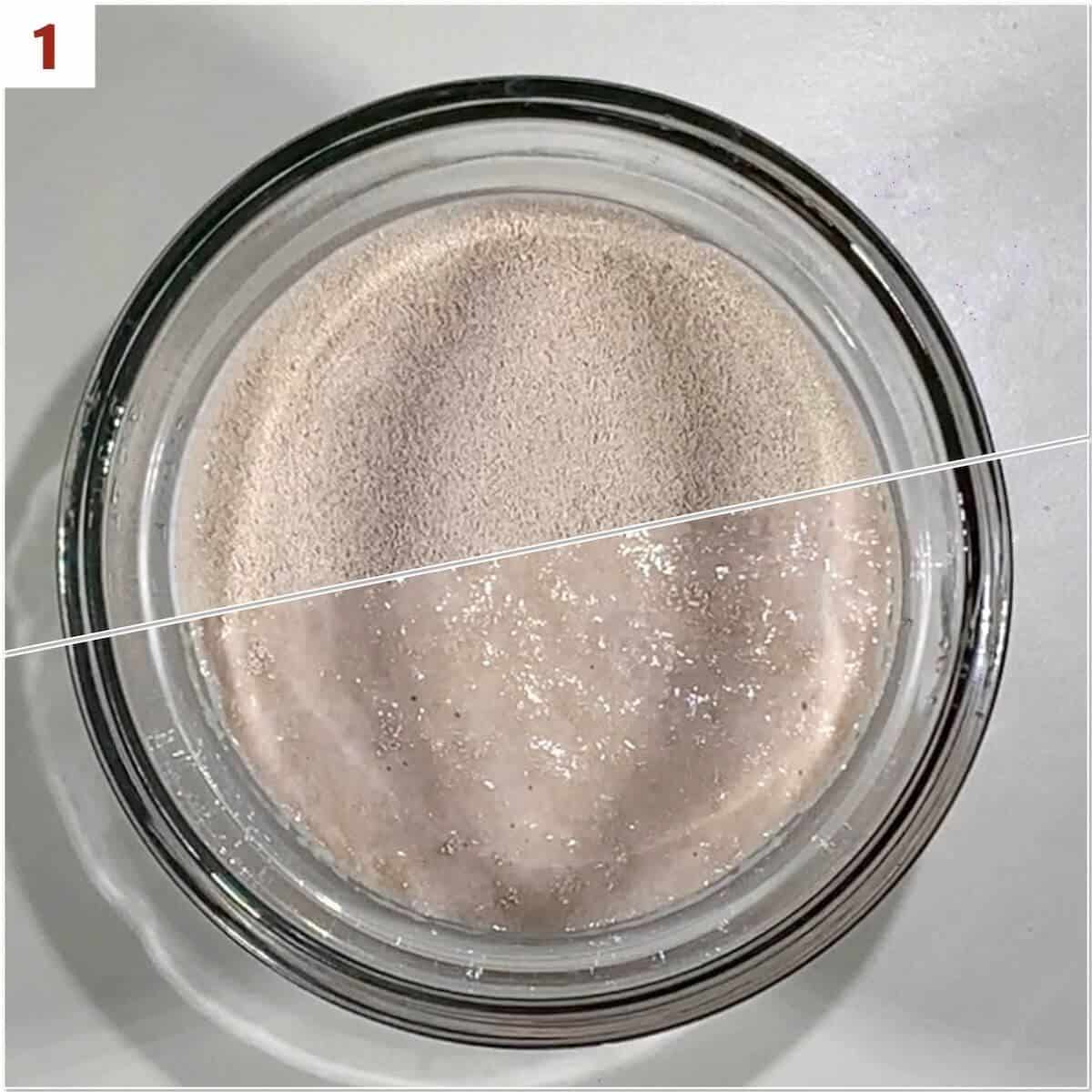
Next is to start mixing the babka dough ingredients, minus the butter. It's important to start developing the gluten in the dough as soon as you can.
Pour the milk mixture into the bowl of a stand mixer fitted with the paddle attachment. Add the eggs and vanilla, then mix on low speed for about 30 seconds (photo 2).

Add the flour, the remaining sugar, and the salt and mix on low speed until a sticky dough forms (photo 3).
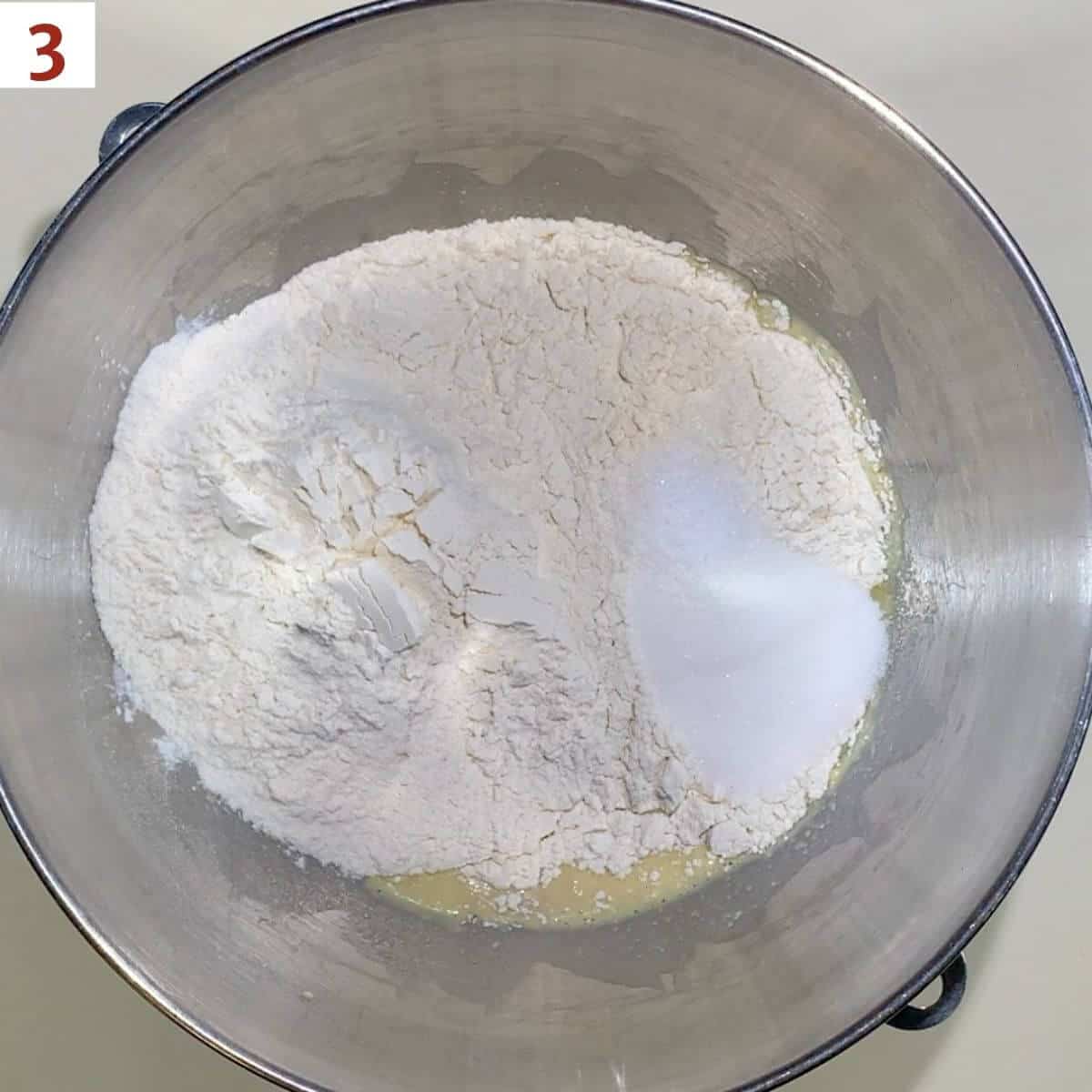
Add the butter, 1 tablespoon at a time, and mix in thoroughly before adding in another tablespoon (photo 4). Slowly introducing the butter into the dough ensures that the gluten network really has a chance to form before it's weighted down by the butter.
You'll want to knead the dough to get a smooth and slightly sticky consistency. If the dough is too wet, add additional flour in 1 tablespoon increments until you get the right texture.
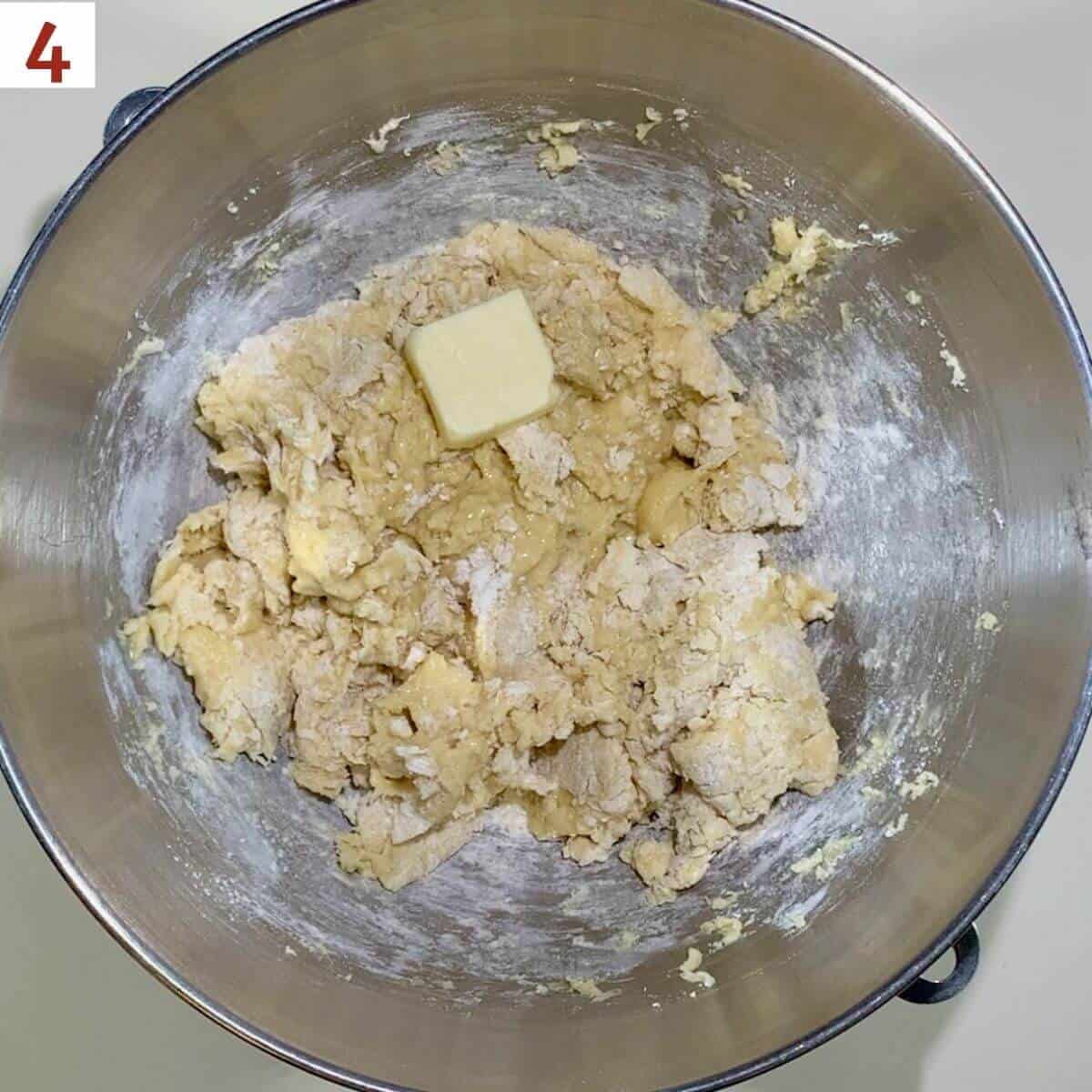
Gather the dough into a ball, stretching it so the top of the ball is smooth. Spray a large bowl with canola oil spray and place the dough ball in smooth side down to wipe it with oil. Turn the dough with the gathered rough part of the dough down and the smooth surface of the ball facing up.
Cover the bowl with a kitchen towel or plastic wrap and let rise in a warm place for about 1 hour, or until the dough has doubled in size (photo 5). The inside of a cool oven with the light on works well.

Step 2: Prepare the fudge filling
While the dough is rising, make the fudge filling. In a microwave safe bowl, melt 2 ounces (57 grams) of coarsely chopped chocolate and the butter in short bursts until almost melted, about 1 minute. Stir until the mixture is smooth and all the chocolate has melted. Stir in the cocoa powder, vanilla, espresso powder, and salt (photo 6).
Chill the filling for at least 30 minutes, or until the fudge starts to thicken up and feels spreadable. While it's chilling, roughly chop remaining 6 ounces (170 grams) of chocolate into ¼-inch chunks to sprinkle on the filling. Set aside.

Step 3: Shape the babka
This is where making babka differs from just making a basic loaf of bread, or even braiding challah.
Once the dough has doubled in size, lightly dust a clean surface with flour and roll the dough out to a rectangle, roughly 15- x 17-inches, with a long side facing you. Spread the fudge over the surface of the dough using a small offset spatula, then sprinkle the chopped chocolate evenly over the filling.
Starting with the long side, tightly roll the dough up from the bottom, making a 17-inch rope (photo 7). Chill the rope for at least 30 minutes (chilling helps the dough hold its shape while you twist it).
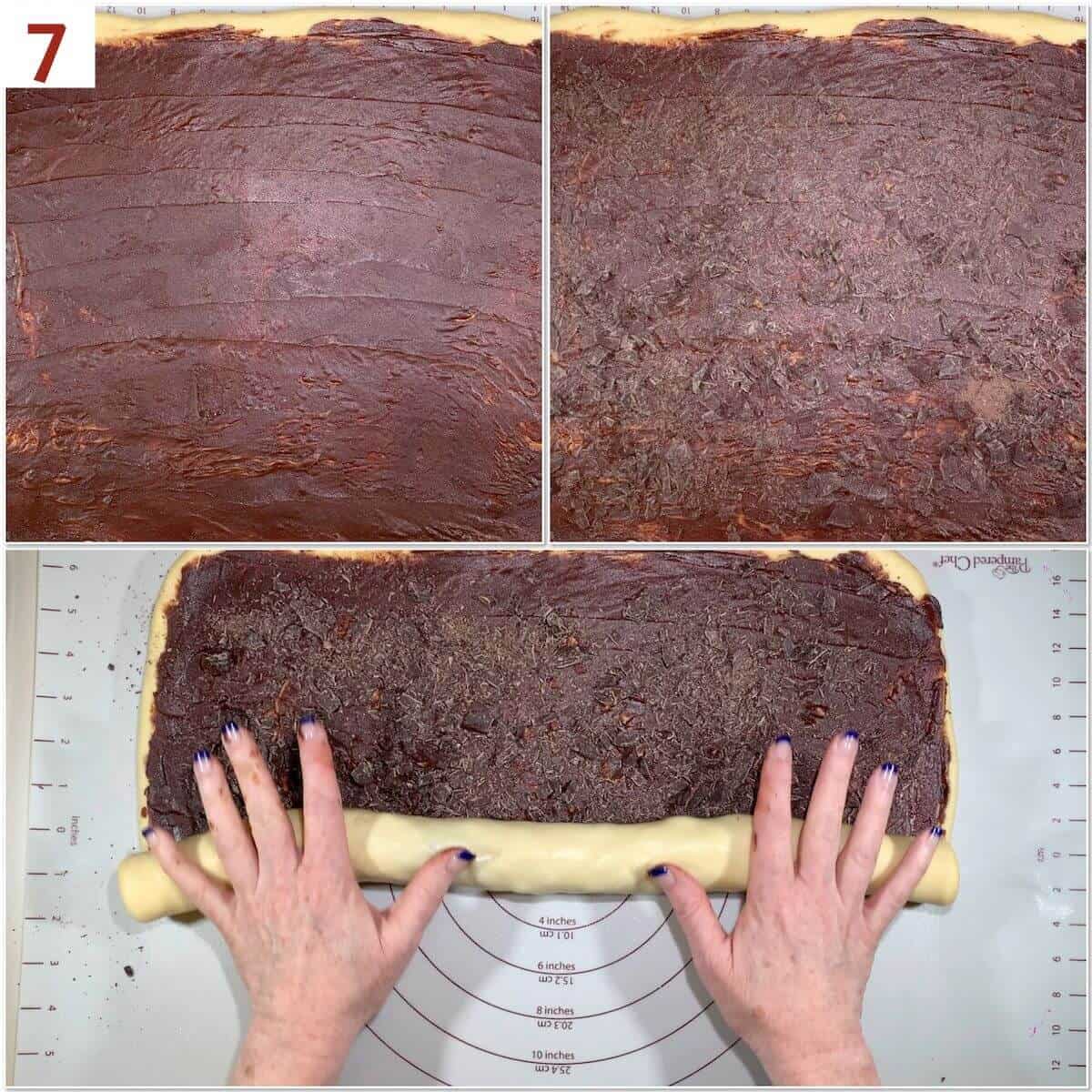
Split the log down the middle, leaving about 2-inches connected at one end. I use a bench scraper rather than a knife to avoid cutting through the mat.
Turn the legs cut side up. Wrap one leg over the other, keeping the cut sides facing up, then repeat until you have a rope twist (photo 8).
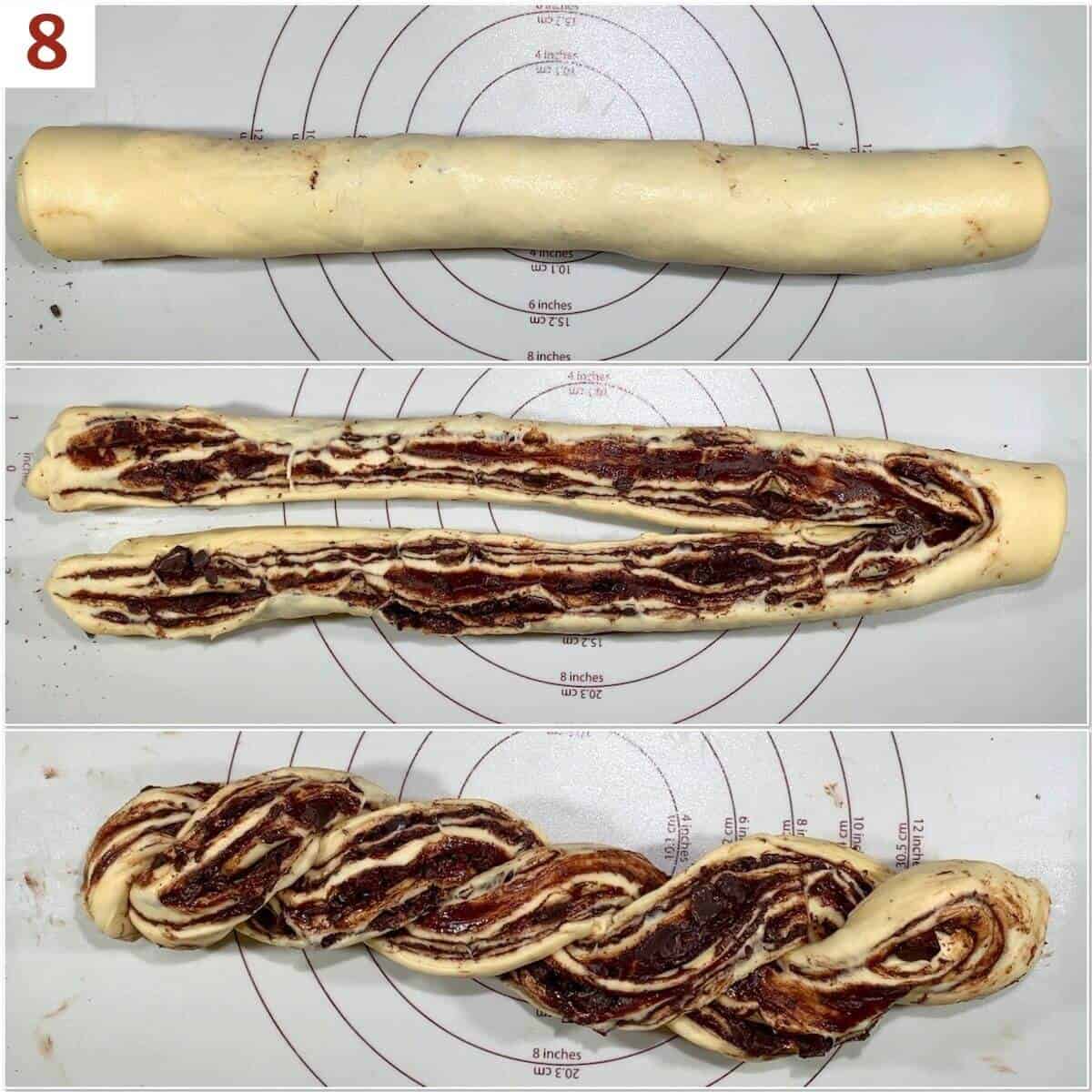
Squish the dough together and transfer it to a standard loaf pan lined with parchment paper, tucking in any stray chocolate chunks. Whisk the egg with 1 tablespoon of water and brush the egg wash over the loaf with a pastry brush. Cover the loaf with a kitchen towel or a piece of plastic wrap and let it rest for 30 minutes (photo 9).

Step 4: Bake the babka
Place the loaf pan on a quarter sheet baking pan and bake at 350˚F for 45 minutes. Cover the top with foil after about 30 minutes if it's getting too dark.
Reduce the oven temperature to 325°F and continue to bake until the top of the babka is deep brown, about 15 minutes more, and the loaf sounds hollow when tapped on the top (photo 10). The babka will be fully baked when the center reads at least 190°F.

Storage instructions
Chocolate Babka will keep on the counter for a few days, but it's best eaten fresh. For longer storage, wrap it in plastic wrap and then freeze in an airtight bag for up to 1 month. To defrost, place on the countertop for several hours, and reheat in the oven at 350°F for 10 minutes before serving.
Questions asked and answered
Here are some questions that you might have...
Babka has its roots in the Eastern European Jewish community who brought it with them as they migrated to the New World.
At its core, babka (aka swirl bread) is a brioche bread recipe that's spread with some sort of filling before being rolled up, cinnamon roll-style. Actually, the dough is similar to a basic challah recipe also, just subbing in milk and butter for the water and oil. Given babka's origin story, that's not surprising because Jewish bakers bake challah for the weekly Sabbath meal.
Both babka and challah are shaped breads with their roots in the Jewish community. While their doughs are similar, babka and challah differ in the way they are shaped and how they are used. Challah is a braided egg bread (not baked in a loaf pan) used to celebrate the Jewish Sabbath and many holiday observances. Babka is part bread, part cake, that's swirled with a sweet filling and baked as a loaf.
Chocolate Babka takes a long time to bake, and the top will get dark brown long before the center has fully baked. Remember that yeast is pushing against a lot of fat and filling, and the oven heat will have a hard time penetrating all that. Let the babka bake at least an hour or so. The best way to check that the center is done is with a digital thermometer reading at least 190°F.
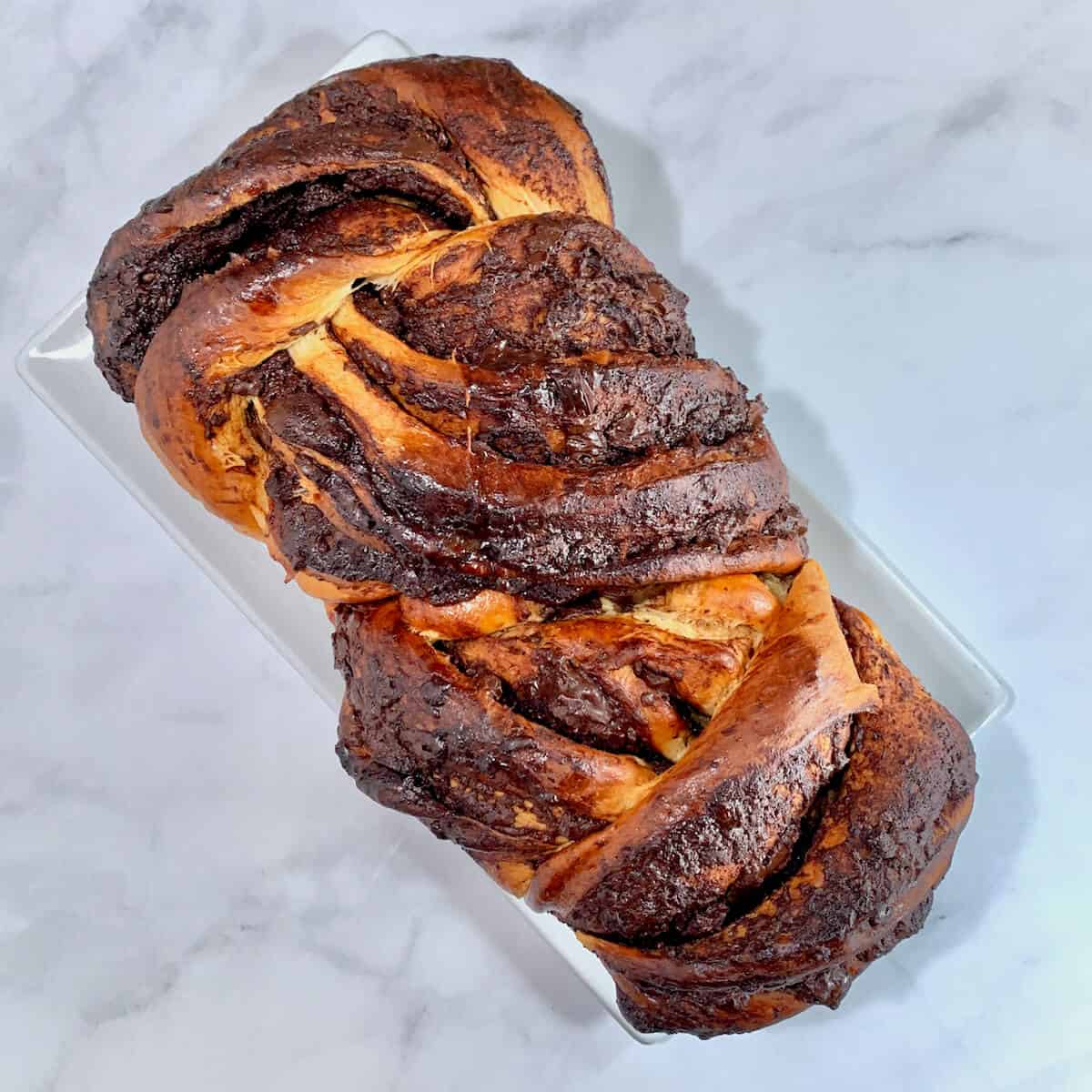
How to shape a Couronne
A Couronne is a ring-shaped babka is where the rope-braided dough has the ends meeting and tucked in together. Bake on a half sheet baking pan lined with a Silpat silicone mat or parchment paper for about 45 minutes or until it's golden brown. A Chocolate Couronne is perfect for Easter brunch!
Babka is better than brioche
Don't get me wrong, brioche has its place at the table, but I'll take a slice of Chocolate Babka over brioche any day! The soft, rich bread is enhanced by the deep flavor of fudge, not to mention pools of melted chocolate chunks!
Yummm...

It's also very pretty and surprising. You never know what the swirl pattern will be at the point you cut into it!

Chocolate Babka cake makes an elegant treat for brunch, afternoon tea, or dessert. Add it to your baking repertoire. You'll be glad you did!
Slainté! L’chaim! Cheers!
Tammy
Try these recipes next
These recipes are for shaped bread, like challah and babka, and some even use sourdough starter discard. Go ahead and play with your food! Here are some ideas to get you started:

I hope you like this recipe! Do you have any questions I can help with? Let me know! Or, if you made the recipe, I'd love for you to leave a comment and rating. Thanks!

Chocolate Babka
Equipment
Ingredients
For the dough
- ¾ cup milk, warmed between 100 to 110°F
- ¼ cup granulated sugar, divided
- 2¼ teaspoons instant yeast, or Active Dry, see Recipe Notes
- 2 large eggs, at room temperature
- 1 teaspoon pure vanilla extract
- 3½ cups all-purpose flour, plus more as needed
- ½ teaspoon kosher salt
- 4 tablespoons unsalted butter, softened
For the filling
- 8 ounces dark chocolate, coarsely chopped, divided (1⅓ cups), see Recipe Notes
- 4 tablespoons unsalted butter, melted
- 1 tablespoon cocoa powder, see Recipe Notes
- 1 teaspoon pure vanilla extract
- ½ teaspoon espresso powder, optional, see Recipe Notes
- ⅛ teaspoon kosher salt
- 1 large egg, beaten plus 1 Tablespoon water, for egg wash
Instructions
- Prepare the dough: Heat the milk until it’s warm to the touch, about 100 °F to 110 °F as read on a digital thermometer. Stir in 1 teaspoon of the sugar, then sprinkle the yeast over the milk and set aside to proof for about 5 minutes or until bubbles form on the surface of the milk. If the yeast doesn't get foamy, get yourself fresh yeast and try again.
- Pour the milk mixture into the bowl of a stand mixer fitted with the paddle attachment. Add the eggs and vanilla, then mix on low speed for about 30 seconds. Add the flour, the remaining sugar, and the salt and mix on low speed until a sticky dough forms. Add the butter, 1 tablespoon at a time, and mix in thoroughly before adding in another tablespoon.
- Switch to the dough hook and knead the dough on medium speed until a smooth and slightly sticky dough forms, about 5 to 10 minutes. Add more flour in 1 tablespoon increments as needed to make the dough the right consistency.
- Gather the dough into a ball, stretching it so the top of the ball is smooth. Spray a large bowl with canola oil spray and place the dough ball in smooth side down to wipe it with oil. Turn the dough with the gathered rough part of the dough down and the smooth surface of the ball facing up. Cover the bowl with a kitchen towel or plastic wrap and let rise in a warm place for about 1 hour, or until the dough has doubled in size. The inside of a cool oven with the light on works well.
- Make the filling: In a microwave safe bowl, melt 2 ounces (⅓ cup, 57 grams) of coarsely chopped chocolate and the butter in short bursts until almost melted, about 1 minute. Stir until the mixture is smooth and all the chocolate has melted. Stir in the cocoa powder, vanilla, espresso powder, and salt. Chill the filling for at least 30 minutes, or until the fudge starts to thicken up and feels spreadable.
- Roughly chop remaining 6 ounces (1 cup, 170 grams) of chocolate into ¼-inch chunks to sprinkle on the filling. Set aside.
- Shape the babka: Coat a standard loaf pan with baking spray and line with parchment paper, leaving an 2-inch overhand on the long sides. Set aside.
- Once the dough has doubled, lightly dust a clean surface with flour and roll the dough out to a rectangle, roughly 15- x 17-inches, with a long side facing you. Spread the fudge over the surface of the dough using a small offset spatula, then sprinkle the chopped chocolate evenly over the filling.
- Starting with the long side, tightly roll the dough up from the bottom, making a 17-inch rope. Chill the rope for at least 30 minutes (chilling helps the dough hold its shape while you twist it).
- Slice the dough in half lengthwise with a bench scraper, leaving about 2 inches connected at one end. You’ll have two 17-inch long legs. Turn the legs cut side up. Wrap one leg over the other, keeping the cut sides facing up, then repeat until you have a rope twist.
- Squish the dough together and transfer it to the prepared loaf pan, tucking in any stray chocolate chunks. Whisk the egg with 1 tablespoon of water and brush the egg wash over the loaf with a pastry brush. Cover the loaf with a kitchen towel or a piece of plastic wrap and let it rest for 30 minutes.
- Bake the babka: While the babka loaf is resting, preheat the oven to 350 °F. Place the loaf pan on a quarter sheet baking pan and bake for 45 minutes. Cover the top with foil after about 30 minutes if it's getting too dark.
- Reduce the oven temperature to 325 °F and continue to bake until the top of the babka is deep brown, about 15 minutes more, and the loaf sounds hollow when tapped on the top. The babka will be fully baked when the center reads at least 190 °F.
- Let the babka cool in the pan for 15 minutes, then use the parchment paper to lift it out of the pan and transfer it to a wire cooling rack. Let it cool to room temperature. When ready to serve, warm the babka or serve at room temperature. Slice thickly and enjoy!
- Storage instructions: Chocolate Babka will keep on the counter for a few days, but it's best eaten fresh. For longer storage, wrap it in plastic wrap and then freeze in an airtight bag for up to 1 month. To defrost, place on the countertop for several hours, and reheat in the oven at 350°F for 10 minutes before serving.


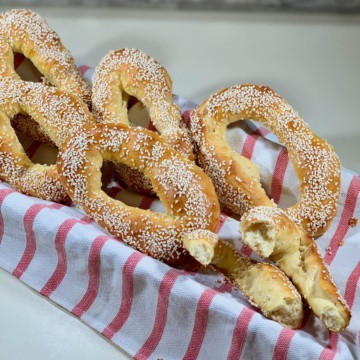

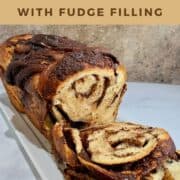

Comments
No Comments